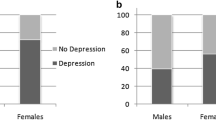Abstract
Juvenile neuronal ceroid lipofuscinosis (JNCL; CLN3 disease; Batten disease) is an autosomal recessive neurodegenerative disease of childhood. Symptoms typically present at school age with vision loss followed by progressive cognitive decline, motor dysfunction, seizures, and behavior problems. Studies on sex differences in JNCL have yielded mixed results, but parent anecdotes suggest that females experience a more precipitous disease course. Therefore, we sought to determine if sex-based differences exist in JNCL. We used data from the Unified Batten Disease Rating Scale (UBDRS), the Batten Disease Support and Research Association (BDSRA) database, and the PedsQL quality of life (QoL) survey to evaluate sex-based differences in functional independence and time from symptom onset to death. On average, females had JNCL symptom onset one year later and death one year earlier than did males. Despite a later age at onset, females had lower functional capability, earlier loss of independent function, and lower physical QoL. Future research in sex differences in JNCL may help to further understand the biological mechanisms underpinning the disease course and may point to targeted therapies.






Similar content being viewed by others
References
Aberg LE, Tiitinen A, Åutti TH, Kivisaari L, Santavouri P (2002) Hyperandrogenism in girls with juvenile neuronal ceroid lipofuscinosis. Eur J Paediatr Neurol 6:199–205
Adams HR, Kwon J, Marshall FJ, de Blieck EA, Pearce DA, Mink JW (2007) Neuropsychological symptoms of juvenile-onset batten disease: Experiences from 2 studies. J Child Neurol 22:621–627
Adams HR, Beck CA, Levy E et al. (2010) Genotype does not predict severity of behavioural phenotype in juvenile neuronal ceroid lipofuscinosis (batten disease). Dev Med Child Neurol 52:637–643
Bäckman ML, Santavuori PR, Åberg LE, Aronen ET (2005) Psychiatric symptoms of children and adolescents with juvenile neuronal ceroid lipofuscinosis. J Intellect Disabil Res 49:25–32
Boustany R-M (1996). Batten disease or neuronal ceroid lipofuscinosis. Moser HW (ed) Handbook of clinical neurology: Elsevier, Amsterdam, 22(66):671–700
Brann DW, Dhandapani K, Wakade C, Mahesh VB, Khan MM (2007) Neurotrophic and neuroprotective actions of estrogen: Basic mechanisms and clinical implications. Steroids 72:381–405
Chattopadhyay S, Ito M, Cooper JD et al. (2002) An autoantibody inhibitory to glutamic acid decarboxylase in the neurodegenerative disorder batten disease. Hum Mol Genet 11:1421–1431
Gillies GE, McArthur S (2010) Estrogen actions in the brain and the basis for differential action in men and women: A case for sex-specific medicines. Pharmacol Rev 62:155–198
Goebel HH, Kohlschütter A (2001) Dementia in the neuronal ceroid-lipofuscinoses. Adv Exp Med Biol 487:211–217
Grimaldi CM (2006) Sex and systemic lupus erythematosus: The role of the sex hormones estrogen and prolactin on the regulation of autoreactive b cells. Curr Opin Rheumatol 18:456–461
Hofman I, Kohlschütter A, Santavuori P et al. (1999). Cln3 juvenile ncl. Goebel HH, Mole SE, Lake BD (eds). The neuronal ceroid lipofuscinoses (batten disease): IOS Press, Amsterdam, pp 55-73
Kwon JM, Adams H, Rothberg PG et al. (2011) Quantifying physical decline in juvenile neuronal ceroid lipofuscinosis (batten disease). Neurology 77(20):1801-1807
Lim MJ, Beake J, Bible E et al. (2006) Distinct patterns of serum immunoreactivity as evidence for multiple brain-directed autoantibodies in juvenile neuronal ceroid lipofuscinosis. Neuropathol Appl Neurobiol 32:469–482
Marshall FJ, de Blieck EA, Mink JW et al. (2005) A clinical rating scale for batten disease: Reliable and relevant for clinical trials. Neurology 65:275–279
McCombe PA, Greer JM, Mackay IR (2009) Sexual dimorphism in autoimmune disease. Curr Mol Med 9:1058–1079
McEwen BS, Alves SE (1999) Estrogen actions in the central nervous system. Endocr Rev 20:279–307
Mondschein ER, Adolph KE, Tamis-LeMonda CS (2000) Gender bias in mothers' expectations about infant crawling. J Exp Child Psychol 77:304–316
Morrongiello BA, Dawber T (1999) Parental influences on toddlers' injury-risk behaviors: Are sons and daughters socialized differently? J Appl Dev Psychol 20:227–251
Rothberg PG, Ramirez-Montealegre D, Frazier SD, Pearce DA (2004) Homogeneous polymerase chain reaction nucleobase quenching assay to detect the 1-kbp deletion in cln3 that causes batten disease. J Mol Diagn 6:260–263
Rowland T (2005) Aerobic fitness. Children's exercise physiology. Human Kinetics, Champaign, IL
Santavuori P, Lauronen L, Kirveskari E, Åberg L, Sainio K, Autti T (2000) Neuronal ceroid lipofuscinoses in childhood. Neurol Sci 21:S35–41
Seehafer SS, Ramirez-Montealegre D, Wong AM et al. (2011) Immunosuppression alters disease severity in juvenile batten disease mice. J Neuroimmunol 230:169–172
Varni JW, Seid M, Kurtin PS (2001) Pedsql 4.0: Reliability and validity of the pediatric quality of life inventory version 4.0 generic core scales in healthy and patient populations. Med Care 39:800–812
Acknowledgments
The authors would like to thank Paul Rothberg, PhD for his contributions to genetic data. We also thank the patients and families. The project described was supported by Award Number U54NS065768 from the National Institute of Neurological Disorders and Stroke. The content is solely the responsibility of the authors and does not necessarily represent the official views of the National Institute of Neurological Disorders and Stroke or the National Institutes of Health." This work was also supported by NIH Grants R01NS060022, K12NS066098, K23NS058756, and TL1RR024136, the Batten Disease Support and Research Association, the Strong Children's Research Center, and the Geoffrey Waasdorp Pediatric Neurology Fund.
Author information
Authors and Affiliations
Corresponding author
Additional information
Communicated by: Ertan Mayatepek
Competing interest: None declared.
An erratum to this article can be found at http://dx.doi.org/10.1007/s10545-011-9442-1.
Rights and permissions
About this article
Cite this article
Cialone, J., Adams, H., Augustine, E.F. et al. Females experience a more severe disease course in batten disease. J Inherit Metab Dis 35, 549–555 (2012). https://doi.org/10.1007/s10545-011-9421-6
Received:
Revised:
Accepted:
Published:
Issue Date:
DOI: https://doi.org/10.1007/s10545-011-9421-6




